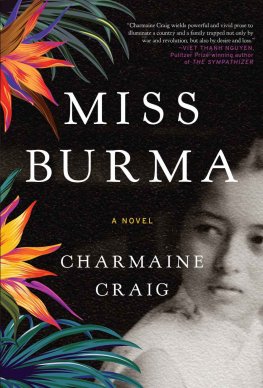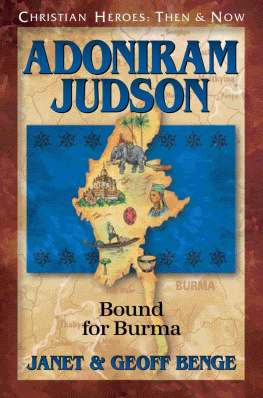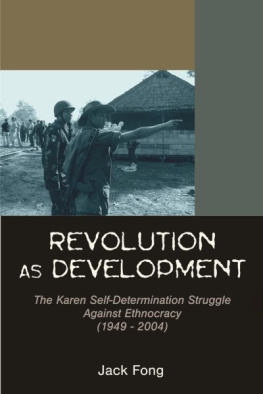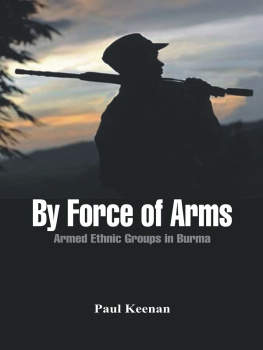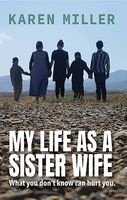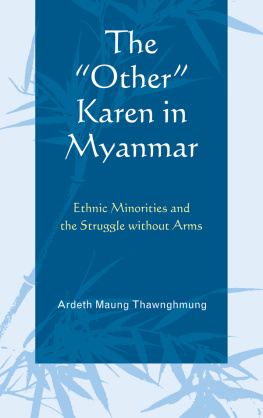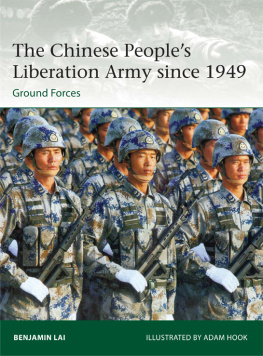Editors Preface
This book comprises two very different, almost opposite, perspectives on five decades in the worlds longest civil war. Here the same conflictthe beginnings, daily life, struggles, and joysis explored through two lenses: that of a soldier and that of a teacher.
Brigadier Saw Ralph Hodgson and Naw Sheera Hodgsons enduring involvement in the Karen Revolution has afforded them a long and broad view of the conflict.1 From day one in 1949 through to their retirement in 1997, they were drawn into some of the key events of the revolution and actively worked with some of its key players.
Saw Ralphs story is that of a combatant, a guerrilla, a general, and a strategist. He came from a privileged cosmopolitan Anglo-Karen family but chose to walk away from that to live as a revolutionary in the jungle. He found success in the rebel army and rose quickly through the ranks. He became general staff officer for the Karen National Liberation Army (KNLA) and took part in some of its most definitive events. In the KNLA he found what he loved: adventure, camaraderie, a sense of purpose, and a life very different from what was expected of him. But it wasnt without great sacrifice. He was forced to cut all contact with his close-knit family, and he expected never to see them again. Drawn to the excitement of battle, Saw Ralph was forever away from his wife, Naw Sheera, and their children.
Naw Sheera was born in the jungle. The civil war was thrust on her remote village when the Burmese burned it to the ground and she made a remarkable escape. At a young age she learned to survive and depended on these skills to raise four children alone in the midst of the revolution. As a young woman she was determined to become a teacher. That determination remains today in her encouragement of her grandchildrens education and spiritual growth. Her Christian faith is her unshakeable rock, and by her own recognition it was through faith and prayer that she survived.
Married for over fifty years, Saw Ralph and Naw Sheera have intertwined lives, but their journeys didnt truly intersect until they reached old age, after they had left the war behind and moved to a life of peace in suburban Australia.
When the Hodgsons arrived in Australia, Saw Ralphs relatives came from all over the world to see him. They wanted to know where hed been and what hed done during the fifty years he was away. Ever a practical man, Saw Ralph decided to write down his story so he didnt have to explain it over and over again. He learned to use a computer and began writing the details. Some years later his niece Maureen arranged for me to help pull it all together. As we heard more of the incredible life Naw Sheera had lived we felt we would be remiss not to include her story in the book too.
We started with Saw Ralph. Sitting in their living room in Perth, he told me the stories of his adventures. Despite being in his late eighties, his memory was incredible. He could remember precise guns used in particular battles, but it soon became clear that it was harder for him to articulate his feelings and reactions. He was forced to explore key events in his life that he had not contemplated since they happened. He had to face his drinking problem and the dark days in the KNLAs history. At first, Saw Ralph refused to include any reference to religion even though his Christian faith has played a pervasive role in his life. He was burned by his experience with the Buddhist split from the KNLA. Always the loyal soldier, he was hesitant to discuss events that reflected poorly on the KNLA. After frank discussions on the importance of writing a warts-and-all account he agreed to include the events.
Likewise, Naw Sheera struggled to express how she felt. At first, she would not discuss her many brothers who died in infancy and her own sons early death. It became clear that this would be a difficult emotional journey for them both. What started as a military memoir became a deeply personal story in which their strengths and flaws were laid bare. Over time they learned how to describe their feelings and open up to each otherand to meabout experiences they had suppressed for decades.
Over the four years it took to compile this book, I got to know Naw Sheera, Saw Ralph, and their family well, and they got to know mine. I attended many prayer services to celebrate birthdays and anniversaries. I watched as Saw Ralph made speeches on Heros Day just as I imagine he had done when addressing his troops in the jungle.
There were practical challenges too. Saw Ralphs English is excellent, if a little old fashioned, so we were able to communicate directly. Naw Sheera speaks four languages, none of which I understand, unfortunately. So a grandchild of one of Naw Sheeras friends translated for her. Both Saw Ralph and Naw Sheera struggled with dates and the sequence of events. Over such long lifetimes, precise dates had lost their relevance. Furthermore, all of Saw Ralphs personal documents were left behind at the KNLA headquarters in Manerplaw when it was destroyed by the Burmese armed forces, so we fact checked where possible and resequenced where necessary.
Saw Ralph once showed me a certificate he had received from the Australian Karen Association and told me, After fifty years in the Karen Revolution this is all I have. There is still no victory, no independent Kawthoolei for the Karen people. For Saw Ralph and Naw Sheera, I think this book is also about having something to show for the decades of struggle. Here they share what they did, their resilience, how they succeeded, and how they survived.2
We wish to thank Jangai Jap, a PhD candidate in political science at George Washington University for her assistance with background research; Xiaoxue Xiao, a graduate of Renmin University of China and of the Master of Architecture program at Columbia Universitys Graduate School of Architecture, Planning, and Preservation, for her assistance in preparing the images and maps; and Elizabeth Sein, granddaughter of a Karen official, who generously contributed her services as a translator in Perth. We would also like to thank the editorial team at Cornell University Press and the two anonymous reviewers for their helpful comments on earlier drafts.
. Saw is a Karen honorific equivalent to Mr. in English, while Naw is an honorific for Karen adult women equivalent to Mrs. or Ms. Both honorifics are primarily used by Sgaw Karens, one of the Karen subgroups. To protect his family, Saw Ralph never used his family name after he joined the revolution. He was known only as Saw Ralph or by his rankfor example, Colonel Ralph.
. In 1989, following mass demonstrations for democracy that were brutally repressed, the ruling military junta Burmanized place names in Myanmar. The name of the country was changed from Burma to Myanmar, and Rangoon became known as Yangon. The names are interchangeable in the Burmese language, but their use has become a politicized issue. Myanmar is the main term in the country and for official purposes, but Burma is still often used in historical writings and the English language. Saw Ralph and Naw Sheera, like many Karens, continue to use pre-1989 place names, including Burma for the country and Rangoon for its largest city. They were at war with the Burmese military in 1989 and the move represented a further Burmanization of the country by the ethnic-Burman military. Additionally, most of the events discussed in this book occurred before place names were Burmanized in 1989. Therefore, the pre-1989 official place names are used throughout this book. Burman (Bamar) generally refers to the majority ethnic group, while Burmese is used for all peoples in the country at large.


